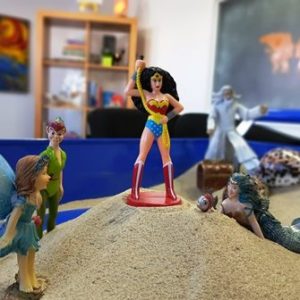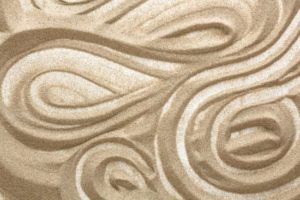Whether you work on a canvas with paint or engage in zen-tangle doodles on paper, sculpt with clay or dance, research says the act of creating art has empathic healing properties. Many art therapy practices like Empowered Art Therapy use different expressive, creative therapeutic approaches to help their clients to bring positive change to their lives. Sandplay therapy is one of those expressive therapies!
Certainly, when verbal therapy doesn’t work, art therapy provides a way to help individuals tap into their inner thoughts, emotions and past experiences. Likewise, Sandplay therapy helps individuals open up emotions they may have been pushing back by arranging miniature figurines or symbols in the safe confines of a sand tray to tell their story. It might sound like simple play, but it’s actually a compelling therapeutic intervention. This write-up contains all about Sandplay Therapy; let’s find out more!

What is Sandplay Therapy?
Sometimes referred to as Sand Tray therapy (although slightly different approaches), Sandplay therapy is a therapeutic process a Sandplay therapist uses for clients who have been through a traumatic event or wish to work through issues they may be facing. This non-verbal expressive therapy is a hands-on technique a person engages with to express themselves by creating a safe and imaginary mini world. Sandplay therapy involves sand in a sand tray with a blue base, a variety of miniature figurines that the client uses, guided by their felt-sense and engaging with deeper parts of their psyche.
The mini world the client creates may not make immediate sense but with the guidance of a trained Sandplay therapist they begin to recognise the relationship with the mini world they have created, their inner world and outer world experience.
Although this therapy is often used with children, it is also helpful for teens and adults. Many traumatic events are hard to describe and individuals can sometimes struggle to express them verbally. Yet by engaging with things in miniature form, within the safe confines of the sandtray, a safe, external and meta view is offered where different perspectives can be gained.

Sandplay Therapy: The Purpose and where can it be used?
Therapeutic practices like Empowered Art Therapy use this hands-on technique for those who have suffered trauma, grief and loss. Yet it is also beneficial for those who feel stuck in life transitions. Although it may appear to be child’s play and beneficial for young children, who often cannot express their feelings in words; it is also used for teens and adults who have suffered severe emotional wounds and can’t express themselves. This therapeutic technique can help manage anger, mood disorders, anxiety, relationship problems, or learning disabilities.

Sandplay therapy: uses and working
How does it work?
In a relaxed and interactive setting, Sandplay therapy is performed using a timber box with a blue base filled with sand known as sand trays. Participants are invited to pause and connect with the felt-sensings whilst considering their outer world experience. Clients are then invited to add figurines that they feel compelled to chose and arrange them in the sand tray to create a mini world that mirrors some aspects of real people and incidents in their own lives.

The therapist observes…
The therapist observes the choice of figurines and structures the client has made in the sand tray and asks facilitatory questions to help the client gain a different perspective on what the arrangement mirrors in their life and form insight leading to a catalyst for positive change.
The therapeutic process completes…
Afterwards the therapist discusses with the client their choices, their arrangement pattern in the sand, and their figurative or metaphorical connotations. Upon discussion, the client may feel compelled to adjust the world they have created in sand and indeed adjust their lived experience to a preferred way of being.
And finally,
With the help of Sandplay therapy facilitated by a therapist, clients can understand the connection between their inner world and the world they created in the sand tray. Further, clients are motivated to make similar changes in their real world by making changes in their “make-believe world,” i.e., the mini-world created in the sand tray. Sandplay therapy may consist of a few sessions or last several years until the change feels possible. Each person responds to this approach at their own pace.

Sandplay Therapy can be the healing key!
This type of intervention provides a multidimensional form of therapy, allowing people to communicate their internal frustrations; provide emotional release, self-reflection, and realisation. Sandplay therapy is a nonverbal, multisensory, psychodynamic treatment for children, teens and adults.
Many mental health professionals use this therapeutic process to understand sufferers’ reasons for sickness. In fact, research has found Sandplay therapy to be effective in reducing anxiety and depression. Afterall this approach to therapy has been in use since its inception in the 1920s when developed by Margaret Lowenfeld, Dora Kalff and others.
Sandplay therapists are trained mental health professionals for a reason!
It is generally a nonverbal communication of their internal and external existing worlds. For better change, growth and healing, this therapeutic tool is incorporated by qualified therapists in their practices. The experts are skilled and well aware of the step-by-step instructions for conducting spontaneous Sandplay therapy sessions for individuals, children, and adults. They have appropriate sand trays and miniature symbolic and metaphoric figurines so their clients can effectively express their story and engage with the story’s parts in new therapeutic ways.
Trained therapists use Sandplay therapy techniques in a relaxed and interactive setting. These mental health professionals have appropriate educational backgrounds, experience, and an ideal Sandplay therapy setup. Best of all, they know how to make their clients comfortable, whether the client they are working with is a 6-year-old child or a 60-year-old adult. As aforementioned, they are called trained Sandplay therapists for a reason!

In conclusion
Research says Sandplay therapy increases emotional expression, reducing psychological distress while representing traumatic events or incidents in a safe trauma-informed manner. Using this therapeutic intervention, you can put your analytical mind on pause; this allows your wise self to speak up. Contact Empowered Art Therapy today to organise a free ‘Meet and Greet’ with Founder Kerryn Knight to find out more.
References
Cunningham, L. (n.d.). Introduction to sandplay therapy. Sandplay Training Worldwide. Retrieved from https://www.sandplaytrainingworldwide.com/weekend-sandplay-trainings
Dale, M. A., & Lyddon, W. J. (2000). Sandplay: A constructivist strategy for assessment and change. Journal of Constructivist Psychology, 13(2), 135-154. doi: 10.1080/107205300265928
The World Technique. (n.d.). Dr. Margaret Lowenfeld Trust. Retrieved from http://lowenfeld.org/the-world-technique

